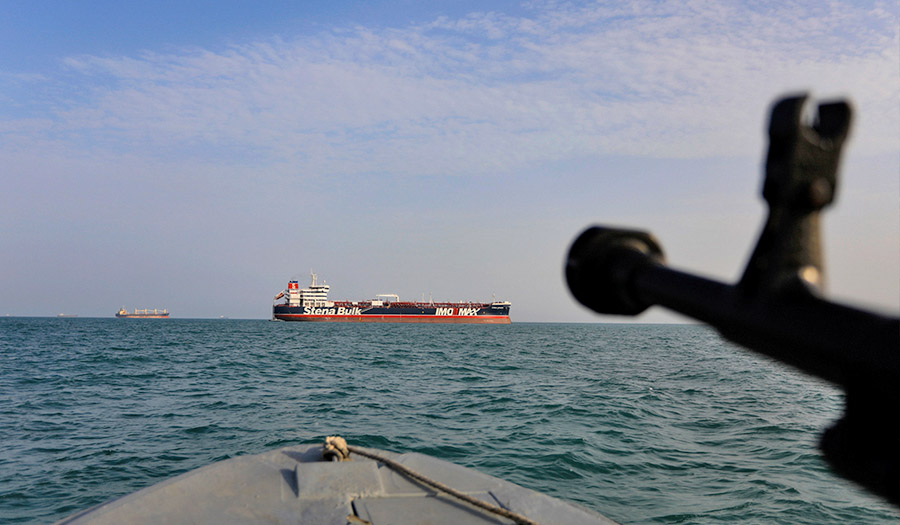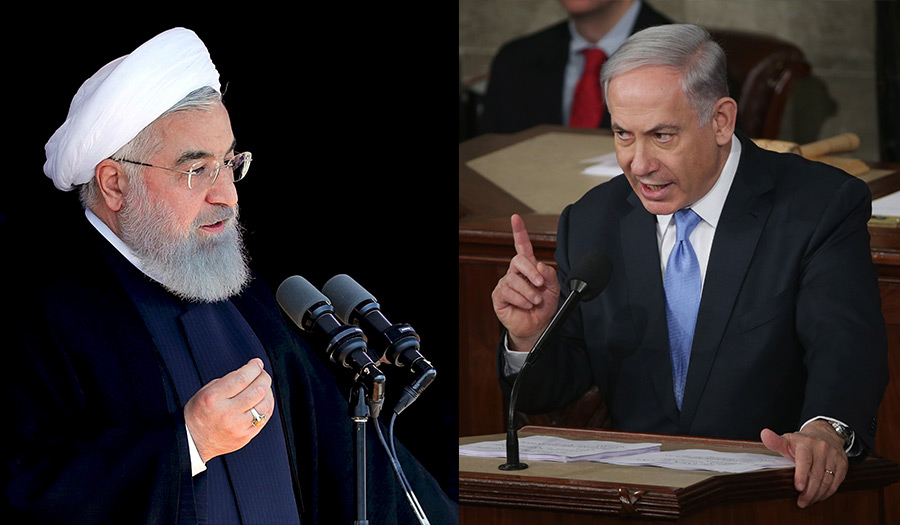 Morteza Akhoondi/Tasnim News Agency via AP
Morteza Akhoondi/Tasnim News Agency via AP
Article
Amid fears of a direct military confrontation between Tehran and Washington, a different conflict has already begun inside the Middle East country.
Learn the why behind the headlines.
Subscribe to the Real Truth for FREE news and analysis.
Subscribe NowSince the United States withdrew from the nuclear accord between Iran and global powers in 2018, tensions in the Middle East have hit boiling points.
Iran’s President Hassan Rouhani stated the nation will enrich uranium to “any amount we want” and has since exceeded the limits of low-enriched uranium as set forth in the deal, according to the UN’s nuclear watchdog, the International Atomic Energy Agency. Experts warn that higher enrichment and a growing stockpile narrow the one-year window Iran would need to have enough material for an atomic weapon.
The Trump administration also said it had detected increased Iranian preparations for possible attacks on U.S. forces and interests in the Persian Gulf area.
With Iranian military threats in mind, including what Washington claimed were Iranian attacks on Saudi oil tankers, the United States is sending armed forces to a Saudi air base.
Britain, too, announced plans to develop and deploy a Europe-led “maritime protection mission” to safeguard shipping in the vital Strait of Hormuz, the key waterway through which one-third of all oil traded by sea passes, in light of Iran’s prior seizure of a British-flagged tanker in the waterway in July.
For its part, Iran denies that it wants nuclear weapons and claims no wrongdoing in the Persian Gulf. Iran’s Foreign Minister Mohammad Javad Zarif said the UK oil tanker that it seized was in violation of “international law on safe passage” in the Strait of Hormuz on the day it was captured. He said the British ship had “turned off its signaling” for longer than is allowed and “was passing through the wrong channels.”
Iran also announced the arrest of 17 Iranians accused of spying on the country’s nuclear and military sites for the CIA and said some of them have been sentenced to death. President Donald Trump completely disagreed.
“That’s totally a false story. That’s another lie,” Mr. Trump said at the White House.
U.S. Secretary of State Mike Pompeo, a former CIA director, said: “The Iranian regime has a long history of lying.”
“I think everyone should take with a grain of salt everything that the Islamic Republic of Iran asserts today,” he said.
The back-and-forth accusations has those in the West fearing it could develop into an actual war in the Mideast, one that would have global consequences.
But underneath the veil of suspicion between the nation’s governments, few realize the battle already going on between Iran’s hardline government and its increasingly Westernized populace.
Growing Disillusionment
To anyone visiting Tehran, Iran’s capital of nearly 9 million people, the paradoxes are quickly apparent.
Girls wearing hijabs roller skate alongside T-shirted boys skateboarding at an outdoor park built by the government.
Men at a political rally shout a refrain of anti-American chants while elsewhere in the city Iranians peruse a Calvin Klein clothing outlet at a mall laden with escalators and fast-food joints.
On the side of a high-rise, an American flag is depicted with bombs instead of stripes and skulls in place of stars, with the words “Down with the U.S.A.” printed over it. Meanwhile, teenagers walk around wearing baseball caps with normal U.S. flags.
In the deeply conservative country, where cultural expression remains tightly controlled by strict rules imposed after the 1979 Islamic Revolution, disillusioned youth are challenging societal norms as they lose sight of the ultra-conservative mentality of the older generation.
“Iran recently observed the 40th anniversary of the Islamic Revolution, but few Iranians beyond the regime’s elites celebrated it,” Brian Hook, the U.S. Special Representative for Iran and a senior advisor to Secretary of State Mike Pompeo, wrote in The New York Times. “The reason for this lack of enthusiasm among ordinary Iranians is no mystery. By any reasonable measure, the revolution has failed to deliver the just and prosperous society that Ayatollah Ruhollah Khomeini and other revolutionary leaders promised the Iranian people in 1979.”
Iran’s population is aging rapidly as many young people have held off on starting families because of high unemployment. The United Nations expects the median age to rise from 27 to 40 by 2030 as a result.
“These days, Iran’s ruling theocracy is best known for oppression, corruption and mismanagement at home, and ghastly sectarian warfare abroad,” Mr. Hook continued. “Through its Shiite militias, the clerical regime has fueled violence and death in Lebanon, Syria, Iraq, Afghanistan, Yemen, and well beyond. Iran’s support for Hezbollah and Hamas has enabled deadly cross-border attacks into Israel.”
“Like the United States, Iran has a vibrant society that wants to be integrated with, not isolated from, other nations. Iranians living in the United States and around the world thrive. But Iranians aren’t thriving in their own country.”
Few remember how the Persian nation looked before 1979—a Western-oriented and secular society under the rule of a shah.
“Under the Shah’s rule, Iran’s economy and educational opportunities expanded,” Business Insider reported. “Britain and the US counted Iran as their major ally in the Middle East, and the Shah forcefully industrialized large segments of the country.”
As a result, as many as 50,000 Iranian students studied at American universities prior to the revolution. Men wearing business suits and women with skirts, button tops and handbags was the norm on the streets.
The generation of youth growing up miffed by the failed promises of the revolution are slowly bringing back this lifestyle.
Classical Story
The ballooning popularity of classical music in the nation’s capital shows this. The Tehran Symphony Orchestra, including female musicians in burgundy headscarves on cello, horn and harp, played works by 19th-century Russian composers for an enraptured crowd in the capital’s main concert venue, Vahdat Hall.
A major draw is Shahrdad Rohani, 65, the orchestra’s charismatic music director. The Iranian-American composer, musician and conductor who has led orchestras in the United States and Europe, said he is proud of his homegrown crop of young musicians.
“Classical music is growing, and as you see, the audience, they are really supporting the arts and classical music,” he told The Associated Press during the intermission of the sold-out concert.
In four decades of conservative Islamic rule, the space for artistic expression in Iran has expanded or contracted, depending on whether political hard-liners or moderates prevail.
In the first decade after the Islamic Revolution, including the eight-year war with Iraq, pop music disappeared from the public sphere, said Nima Mina of the School of Oriental and African Studies at the University of London.
The Tehran Symphony Orchestra, founded in 1933, continued its work after 1979, he said. Live performances were initially rare, but have increased in number since the 1990s.
“I love the work of Rohani,” said concert-goer Ali Reza, 26, who was introduced to classical music by learning to play the piano. He said most of his friends prefer other styles of music, including rock and pop.
Some said there is a generational divide, with older people tending to prefer traditional Iranian music.
“There is a lot of interest in Western culture among the young urban middle class population,” said Mr. Mina, portraying it as pushback against the lifestyle and artistic expression promoted by the authorities.
The War Within
Conservative authorities in Tehran are viewing the societal trends with caution.
The latest battleground is over social media. Hardliners unleashed criticism on a video of children singing and dancing to a Persian pop song that was uploaded to social media.
“The enemy is trying different ways to create anxiety among the people, including by spreading these disturbing videos we have been seeing in cyberspace,” Iran’s education minister stated according to Los Angeles Times.
The publication explained further that “with the rise in popularity of social media platforms, Iranian efforts to remain insular face a greater threat than ever. That’s because the types of entertainment that hard-line authorities have long abhorred are now spread and disseminated throughout society at speeds faster than can be controlled.”
“These viral videos are cracks in the Iranian government controls and the internet has opened them up thanks to the ease of access,” Holly Dagres, an Iran expert at the Atlantic Council, told the news outlet. “In the eyes of hard-liners, messaging apps and the internet have become hubs for incitement against the state. Without their control on the flow of information, it can become a liability for hard-line authorities.”
President Rouhani, who is politically moderate and ran his campaign in 2013 on promises of building a better diplomacy with Western nations, had hoped that the nuclear deal would soften American-Iranian relations.
Yet, since the U.S. pulled out of the deal, “he’s lost ground to [Supreme Leader Ali Khamenei] and other hard-liners who see a Western ‘culture war’ against Iran, while the country’s regional rivals blasted Rouhani’s attempts at diplomacy as duplicitous,” Bloomberg reported.
“The hardliners want to demonstrate they are as powerful as they were before Rouhani’s election…when Iranians gave a candidate who promised ‘change’ a decisive vote,” an NPR article stated.
Burgeoning cultural resistance to the Islamic Republic is nothing new, particularly since 1979. On one hand, diplomatic relations are officially defined by the tensions and fiery rhetoric between Washington and Tehran. On the other, Iranians appear to have many qualities that could fit right into any Western democracy—fun- and freedom-loving, culturally expressive, an interest in science and education, and hospitality.
To better understand the relationship, it is crucial to see the big picture. The Real Truth article Iran and Israel’s Mideast Showdown shows how past relations between Iran and Western democracies foreshadow their future.
This article contains information from The Associated Press.
- Real Truth Magazine Articles
- MIDDLE EAST
 Iran and Israel’s Mideast Showdown
Iran and Israel’s Mideast Showdown
More on Related Topics:
- Explainer: What’s Next for the Gaza Ceasefire, and Will the Truce Last?
- Gaza Truce Progress Slow as Israeli-Hamas Violence Persists
- Situation for Mothers and Babies in Gaza Has ‘Never Been Worse,’ says UNICEF
- For the First Time, the World’s Food Crises Authority Announces a Famine in Gaza
- What to Know About Israel’s Plan to Retake Gaza City


